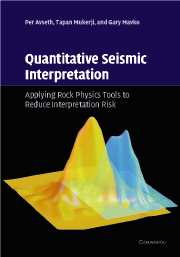Book contents
- Frontmatter
- Contents
- Preface
- 1 Introduction to rock physics
- 2 Rock physics interpretation of texture, lithology and compaction
- 3 Statistical rock physics: Combining rock physics, information theory, and statistics to reduce uncertainty
- 4 Common techniques for quantitative seismic interpretation
- 5 Case studies: Lithology and pore-fluid prediction from seismic data
- 6 Workflows and guidelines
- 7 Hands-on
- References
- Index
- Plate section
5 - Case studies: Lithology and pore-fluid prediction from seismic data
Published online by Cambridge University Press: 27 January 2010
- Frontmatter
- Contents
- Preface
- 1 Introduction to rock physics
- 2 Rock physics interpretation of texture, lithology and compaction
- 3 Statistical rock physics: Combining rock physics, information theory, and statistics to reduce uncertainty
- 4 Common techniques for quantitative seismic interpretation
- 5 Case studies: Lithology and pore-fluid prediction from seismic data
- 6 Workflows and guidelines
- 7 Hands-on
- References
- Index
- Plate section
Summary
The path of precept is long, that of example short and effectual.
SenecaThe case study examples in this chapter make use of the techniques described in the previous chapters, to estimate the uncertainty and map the probability of occurrence of different facies and fluids away from the well locations by combining attributes from seismic analyses with statistical rock physics.
The first case study uses pre-stack seismic amplitude analyses to delineate reservoir zones in the North Sea. In the second study, again in the North Sea, use is made of seismic impedance inversions, statistical rock physics, and geostatistics to characterize the reservoir by mapping probabilities of occurrence of facies and fluids. In the third case study we show how we can combine statistical rock physics, lithofacies interpretation, and AVO analysis to discriminate between lithologies and thereby improve detectability of hydrocarbons from seismic amplitudes in Grane field, North Sea. The fourth study, from West Africa, shows an example of using seismic amplitude analyses and depth trends in rock properties to classify hydrocarbon zones at different depths. The fifth case study is an example of the full workflow of rock physics template (RPT) analysis, starting with the selection of the most appropriate RPT using well-log cross-plot analysis followed by rock physics interpretation of elastic inversion results using the selected template. The example is from the Grane field in the North Sea, the same field as for case study 3.
Information
- Type
- Chapter
- Information
- Quantitative Seismic InterpretationApplying Rock Physics Tools to Reduce Interpretation Risk, pp. 258 - 316Publisher: Cambridge University PressPrint publication year: 2005
